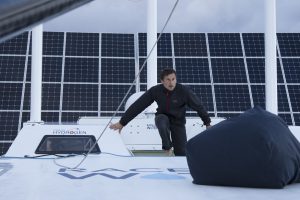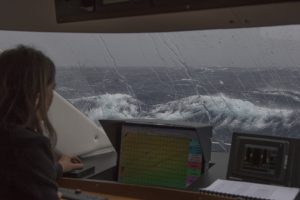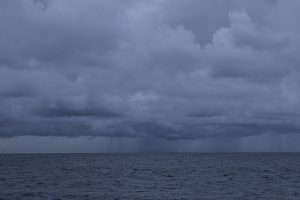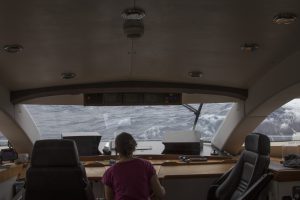Martin had warned us that a depression was approaching from the north, and that there was no way around it. Fortunately, we were able to avoid the worst of it by staying to the south, charting our course to stay within the maximum conditions that Race for Water can withstand. The bulk of the depression passed in front of us, but we still had some strong winds and high seas: 30/35 knots of wind with gusts to 40 knots, and 12 to 15-foot waves.
Fortunately we had time to get ready. It was the first time that we’d experienced those kinds of conditions on Race for Water, so we watched carefully to see how she behaved. We were totally focused. When the wind picked up, we had to retract the solar panel wings so that they didn’t smash into the waves as the seas got higher. At times, Race for Water listed hard enough that the wings were only an inch or so above the waves.
To retract the wings, we have to go out on the bridge and walk right on the panels, which requires some careful maneuvering. Between the rain and the boat listing back and forth, the panels are like a skating rink; whoever goes out on them has to be very agile. In the end, Martin went out on the deck to have a go at it, of course wearing a tether on his harness. In about half an hour, the job was done.

Martin maneuvering in a storm
There was lots to organize inside Race for Water as well. We had to secure the tables and chairs, and stow everything else: computers, video and photo equipment, etc. Everything had to be prepared for the conditions, and we really didn’t have too many things bumping around inside the boat. One of the fridge doors came open, a coffee pot in the storeroom fell off the shelf, and down in the hold, a crate of carrots and one of the extra solar panels broke, but really nothing serious.
In terms of actually sailing the boat, we were running with the wind, and Pascal found a good compromise in terms of power. We raised the rear solar panels for maximum speed as the wind kicked up behind us. We steered Race for Water manually, rather than risk having the autopilot disengage and ending up broadside to a wave. At one point, we stalled out with the autopilot engaged when a 40-knot gust kicked up…and our punishment was a slap from a broadside wave. The impact to the hull was fairly intense, and Race for Water listed pretty dramatically.
Steering Race for Water manually is an exercise in concentration. It’s not easy; she weighs 100 metric tons. We’re always trying to anticipate the path that she’ll take, and we really have to counter-steer when we get picked up by a wave. Even taking turns at the helm every 15-20 minutes, we’re pushed to the limit, going at over 10 knots on the waves.



Rain and wind squall – Annabelle at the helm
In bad weather, little problems can quickly become big problems. If the Zodiac slips out of place, or rudder angle indicator gets disconnected, or the edge of one of the solar panels gets jammed, things can go downhill quickly.
But now it’s over, and we’re fine. The swell was still pretty strong this morning, but it gradually settled down, and so did the wind.
After the rain, the sun always returns.